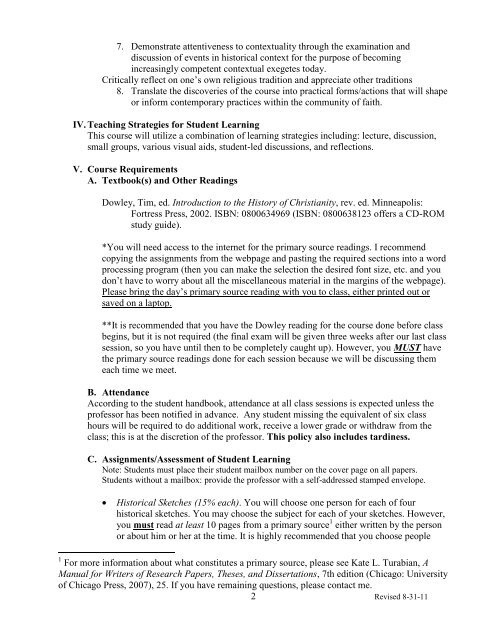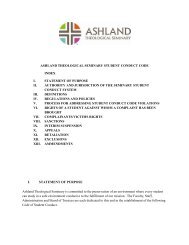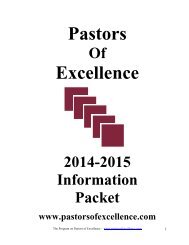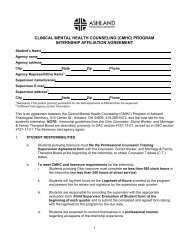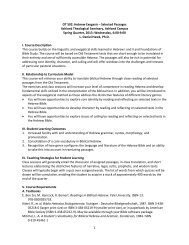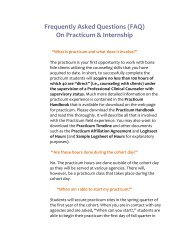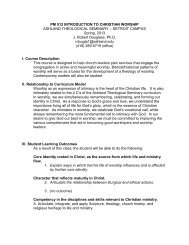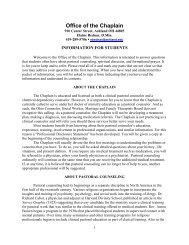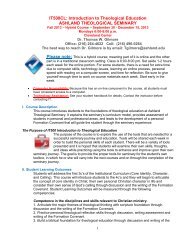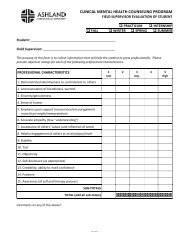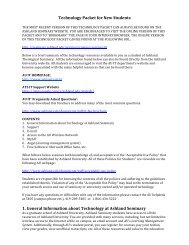Course Number: Course Name - Ashland Theological Seminary
Course Number: Course Name - Ashland Theological Seminary
Course Number: Course Name - Ashland Theological Seminary
You also want an ePaper? Increase the reach of your titles
YUMPU automatically turns print PDFs into web optimized ePapers that Google loves.
7. Demonstrate attentiveness to contextuality through the examination and<br />
discussion of events in historical context for the purpose of becoming<br />
increasingly competent contextual exegetes today.<br />
Critically reflect on one’s own religious tradition and appreciate other traditions<br />
8. Translate the discoveries of the course into practical forms/actions that will shape<br />
or inform contemporary practices within the community of faith.<br />
IV. Teaching Strategies for Student Learning<br />
This course will utilize a combination of learning strategies including: lecture, discussion,<br />
small groups, various visual aids, student-led discussions, and reflections.<br />
V. <strong>Course</strong> Requirements<br />
A. Textbook(s) and Other Readings<br />
Dowley, Tim, ed. Introduction to the History of Christianity, rev. ed. Minneapolis:<br />
Fortress Press, 2002. ISBN: 0800634969 (ISBN: 0800638123 offers a CD-ROM<br />
study guide).<br />
*You will need access to the internet for the primary source readings. I recommend<br />
copying the assignments from the webpage and pasting the required sections into a word<br />
processing program (then you can make the selection the desired font size, etc. and you<br />
don’t have to worry about all the miscellaneous material in the margins of the webpage).<br />
Please bring the day’s primary source reading with you to class, either printed out or<br />
saved on a laptop.<br />
**It is recommended that you have the Dowley reading for the course done before class<br />
begins, but it is not required (the final exam will be given three weeks after our last class<br />
session, so you have until then to be completely caught up). However, you MUST have<br />
the primary source readings done for each session because we will be discussing them<br />
each time we meet.<br />
B. Attendance<br />
According to the student handbook, attendance at all class sessions is expected unless the<br />
professor has been notified in advance. Any student missing the equivalent of six class<br />
hours will be required to do additional work, receive a lower grade or withdraw from the<br />
class; this is at the discretion of the professor. This policy also includes tardiness.<br />
C. Assignments/Assessment of Student Learning<br />
Note: Students must place their student mailbox number on the cover page on all papers.<br />
Students without a mailbox: provide the professor with a self-addressed stamped envelope.<br />
<br />
Historical Sketches (15% each). You will choose one person for each of four<br />
historical sketches. You may choose the subject for each of your sketches. However,<br />
you must read at least 10 pages from a primary source 1 either written by the person<br />
or about him or her at the time. It is highly recommended that you choose people<br />
1 For more information about what constitutes a primary source, please see Kate L. Turabian, A<br />
Manual for Writers of Research Papers, Theses, and Dissertations, 7th edition (Chicago: University<br />
of Chicago Press, 2007), 25. If you have remaining questions, please contact me.<br />
2 Revised 8-31-11


